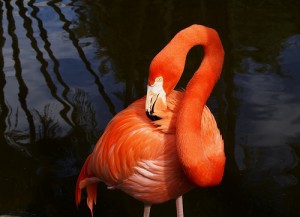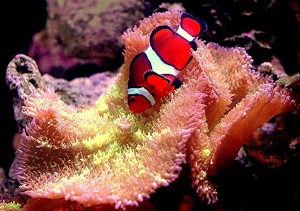Well, color me surprised
Nature is colorful. And the family of pigments that is mostly responsible for these colors are carotenoids. Carotenoids make the apples and tomatoes red, the lemons and grapefruit yellow, the pumpkins oranges and, yes carrots, (from which their name is derived), orange.
Carotenoids also make flamingos and salmon pink, and color the puffin’s bill orange. But those animals cannot produce carotenoids: rather carotenoids are in their diet, and in the case of flamingos and puffins they have a physiological mechanism of concentrating the carotene molecules and bringing them to display their strong colors. Indeed Some of us also use carotenoids as an ornamental physiological addition: remember that horrid orange tan Auntie Mae sported last time you saw her in the dead of winter? Beta-carotene pills. Carotene is not just ornamental in animals, they are also important for eyesight, the immune system, and in decreasing DNA damage that may lead to cancer.

The orange ring surrounding Grand Prismatic Spring is due to carotenoid molecules, produced by huge mats of algae and bacteria. Source: wikimedia commons. Credit: Jim Peaco, US National Park Service
An article published today in Science shows the first case of animals synthesizing carotenoids. Nancy Moran and Tyler Jarvik form the University of Arizona looked at the recently sequenced genome of the pea aphid. The pea aphid is known for having two different colors: green and red. It was not very clear though how the aphids got their color. Aphids feed on sap, and sap does not contain carotenoids. When looking at the genomes of the aphids, Moran and Jarvik found that they contained genes for synthesizing carotenoids: this is the first time carotenoid synthesizing genes are found in animals. The question they naturally asked is “where did those genes come from”? The animal kingdom does not contain genes for making carotenoids, so how come aphids have them? Indeed, when they looked for the most similar genes to the aphid carotenoid synthesizing genes they found that they came from fungi, which means they somehow jumped between fungi and aphids, in a process known as horizontal gene transfer. Horizontal gene transfer is not unheard-of in animals, and is actually quite common in plants (yeah, fungi are not plants, I know that), but this is the first time someone has shown a jump from fungi to animals, and that the trait that this gene conveys — color — became embedded and functional in the genome.
Aphid color is important: red aphids get picked easily by predators off green plants, and vice-versa. So there is an evolutionary aspect here: the carotenoid genes play a role in the predator-driven selection of aphids. So in the case of aphids, as opposed to puffins and flamingo, the selective pressure is that of predation, not of mating. (I’ll refrain from comments about Auntie Mae.)

"Long ago, an ancestor to today's pea aphid somehow internalized a large important chunk of DNA from a fungus. This DNA now allows the aphid to generate its own carotenoid molecules. All animals need carotenoids for body functions as important as eyesight. However this aphid is the only organism in the Animal Kingdom so far to have been reported capable of producing it internally. The rest of us must forage for foods such as carrots, containing carotenoids. The precise way the DNA transfer occurred is not yet understood; however patterns within the DNA conclusively show a link to a fungus. DNA transfer from fungus to animal is unprecedented." (text taken from the NSF announcement). Credit: Zina Deretsky, National Science Foundation
As an aside, many of our pseudogenes and other contents of “junk DNA” are thought to have been acquired by horizontal gene transfer. Still, this is the first time a case of gene transfer that is so clear between two different kingdoms. However, I have the sneaking suspicion that as we sequence more animal, plant, fungal and other genomes of multicellular organism, we would find more cases of “large-leap” HGT of functional genes happening: we just don’t have enough genomes yet to appreciate the frequency of these occurrences!
 Update: this post has been slashdotted. Exercise extreme caution.
Update: this post has been slashdotted. Exercise extreme caution.
Update II: this post has been submitted for the NESCent travel award for the Science Online 2011 conference.
Moran, N., & Jarvik, T. (2010). Lateral Transfer of Genes from Fungi Underlies Carotenoid Production in Aphids Science, 328 (5978), 624-627 DOI: 10.1126/science.1187113
























Wow… also in bacteria, these same carotenoids help golden staphlyococci avoid phagocytosis http://microbes.wordpress.com/2007/03/07/staph-aureus-is-the-color-just-ornamental/
Amazing pictures! For anyone who is a visual learner, just seeing these pictures when you’re talking about a confusing topic such as gene transfer is a benefit. Thanks for the great resource.